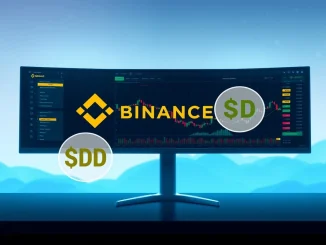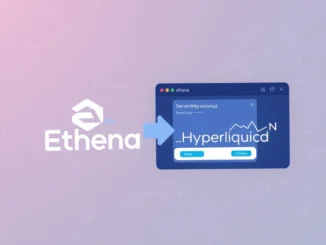
Hold onto your hats, crypto enthusiasts! The decentralized exchange (DEX) Hyperliquid is making headlines, and not for the reasons you might expect. Following the recent Jelly liquidation event, the platform witnessed a staggering USDC outflow of $140 million. Yes, you read that right – $140 million! This significant movement of funds raises eyebrows and prompts crucial questions about market stability and investor confidence in the DeFi space. Let’s dive into what triggered this Hyperliquid outflow and what it means for the broader crypto landscape.
Why the Sudden $140M USDC Outflow from Hyperliquid?
According to data from Parsec, the hefty USDC outflow occurred shortly after the Jelly liquidation. This event seems to have triggered a chain reaction, leading users to withdraw substantial amounts of their USDC holdings from Hyperliquid. But is this an isolated incident, or a symptom of deeper concerns within the platform and the wider DeFi ecosystem?
Adding fuel to the fire, this isn’t Hyperliquid’s first rodeo with substantial outflows. Just prior to this, the exchange experienced another $300 million crypto exchange outflow linked to the liquidation of a massive ETH whale’s long position. These consecutive large outflows paint a picture of potential instability or at least heightened user caution. Let’s break down the key events:
- Jelly Liquidation Event: This event appears to be the immediate trigger for the $140 million USDC outflow.
- Previous $300M Outflow: A prior significant outflow connected to an ETH whale liquidation already placed Hyperliquid under scrutiny.
- Overall Balance Decline: Over the past month, Hyperliquid’s USDC balance has shrunk from approximately $2.5 billion to $2.07 billion, as reported by Wu Blockchain on X. This indicates a consistent trend of funds moving away from the platform.
[img]
Understanding the Impact of Crypto Exchange Outflows
Crypto exchange outflows are not inherently negative, but significant and rapid withdrawals, like the ones Hyperliquid has experienced, can signal various underlying issues. These can range from user concerns about platform stability after liquidations to broader market anxieties affecting the entire DeFi sector. Let’s consider some potential implications:
- Liquidity Concerns: Large outflows can strain the liquidity of a platform, potentially making it harder to execute trades smoothly, especially during volatile market conditions. Reduced DeFi liquidity can lead to wider spreads and increased slippage.
- Erosion of Trust: Successive outflows might erode user trust in the platform. If users perceive increased risk, they are more likely to withdraw their funds, creating a negative feedback loop.
- Market Sentiment Indicator: Significant outflows from a major DEX like Hyperliquid can be interpreted as a negative sentiment indicator for the broader crypto market, suggesting potential risk aversion among investors.
- Regulatory Scrutiny: While not directly linked, large fund movements can sometimes attract the attention of regulatory bodies, particularly if they are associated with market events like liquidations.
DeFi Liquidity: The Lifeblood of Decentralized Finance
DeFi liquidity is paramount for the health and functionality of the decentralized finance ecosystem. It ensures that traders can easily enter and exit positions, facilitates efficient price discovery, and underpins the overall stability of DeFi protocols. When liquidity dries up, or becomes fragmented, the entire system can become more vulnerable to shocks and manipulation. The recent events at Hyperliquid highlight the critical importance of robust liquidity management in DeFi.
Benefits of Strong DeFi Liquidity:
| Benefit | Description |
|---|---|
| Reduced Slippage | Large liquidity pools mean trades can be executed with minimal price impact, reducing slippage for traders. |
| Efficient Price Discovery | Deep liquidity contributes to more accurate and stable price discovery, reflecting true market sentiment. |
| Platform Stability | Platforms with ample liquidity are more resilient to market volatility and large trading volumes. |
| Increased User Confidence | Robust liquidity fosters user confidence, encouraging greater participation and investment in the DeFi ecosystem. |
Challenges to Maintaining DeFi Liquidity:
- Market Volatility: Sudden market downturns can trigger liquidity crunches as users rush to withdraw funds, as seen in the Hyperliquid case.
- Smart Contract Risks: Vulnerabilities in smart contracts can lead to exploits and loss of funds, severely impacting liquidity and user trust.
- Regulatory Uncertainty: The evolving regulatory landscape for DeFi can create uncertainty and discourage liquidity providers from participating.
- Competition: The proliferation of new DeFi platforms and protocols can fragment liquidity across the ecosystem.
Is Hyperliquid’s Future at Risk? Analyzing the Outflow Trend
While the recent Hyperliquid outflow figures are concerning, it’s crucial to maintain perspective. A $140 million outflow, while substantial, needs to be viewed in the context of Hyperliquid’s overall balance, which still remains above $2 billion. However, the trend is undeniably downward, and consecutive large outflows warrant close attention. Is this a temporary blip caused by market jitters after the Jelly liquidation, or is it indicative of a more systemic issue?
Possible Scenarios:
- Short-Term Volatility: The outflows could be a temporary reaction to the Jelly liquidation and broader market uncertainty. As market conditions stabilize and confidence returns, funds might flow back into Hyperliquid.
- Increased Competition: The DeFi space is highly competitive. Users might be migrating to other platforms offering better yields, features, or perceived security.
- Underlying Platform Issues: While there’s no concrete evidence of this, persistent outflows could signal underlying issues with the platform’s security, technology, or risk management practices.
Actionable Insights: What Can Crypto Users Learn?
The Hyperliquid situation offers valuable lessons for crypto users navigating the DeFi landscape:
- Diversification is Key: Don’t keep all your crypto eggs in one basket. Diversify your holdings across multiple platforms and asset classes to mitigate risk.
- Stay Informed: Keep abreast of market news, platform updates, and security audits. Information is your best defense in the volatile crypto world.
- Understand Liquidation Risks: Be fully aware of the liquidation risks associated with leveraged trading and DeFi protocols. Manage your positions responsibly.
- Monitor Platform Health: Keep an eye on key metrics like total value locked (TVL), trading volume, and fund flows for the platforms you use. Significant outflows can be a warning sign.
- Due Diligence is Crucial: Before entrusting your funds to any DeFi platform, conduct thorough research on its security, team, technology, and community reputation.
Conclusion: Navigating the Turbulent Waters of DeFi
The shocking $140 million Hyperliquid outflow following the Jelly liquidation serves as a stark reminder of the inherent volatility and risks within the DeFi space. While Hyperliquid still holds a substantial USDC balance, the trend of outflows is undeniable and requires careful monitoring. For crypto users, this event underscores the importance of vigilance, diversification, and a deep understanding of the platforms they interact with. As the DeFi landscape continues to evolve, staying informed and proactive is paramount to navigating these potentially turbulent waters and safeguarding your investments. The situation at Hyperliquid is a crucial case study in the ongoing saga of DeFi liquidity and market confidence, and its future trajectory will be closely watched by the crypto community.



